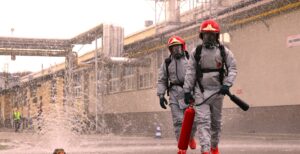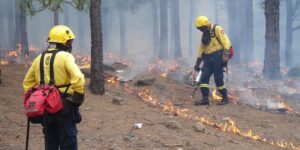
Unlikely Heroes: Incarcerated LA Fire Responders Rise Above Barriers
Wildfires are very, very expensive. Billions of dollars in damages are lost each year (much of which is borne by insurance companies and their insureds) as well as additional billions of dollars expended to suppress (prevent) and fight (quell and extinguish) them. The recent Los Angeles fires represent a worst-case scenario, where extremely high winds and adverse weather conditions coupled with years of drought generated levels of urban devastation that have not been seen before.
For a remarkable contingent of firefighters, however, the catastrophe was also a truly unique opportunity to do better for themselves. California’s prison inmate firefighters volunteer to put their lives on the line for the very community that incarcerates them. By doing so, they have the opportunity to rise above their situation, contribute positively to their community, and create a chance for a better future for themselves and their families.
California’s Wildfire Statistics
Perhaps not surprisingly, California experiences more, bigger, and costlier wildfires than any other U.S. state (with the word ‘wildfire’ distinguishing the difference between a fire in remote, rural, and forested areas versus fires that occur within urban areas). According to the Insurance Information Institute, of the top ten most expensive wildfires in the United States, nine occurred in California over the past eight years (Colorado’s 2021 Marshall Fire is the only outlier). In terms of most destructive wildfires (most number of acres burned), the Palisades and Eaton fires have already notched up to numbers three (20,438) and four (13,690) on the list, topped only by the Camp Fire of 2018 (153,336), and the Tubbs Fire of 2017 (36,807). These disasters amass a series of staggering losses, from lives to property to memories and histories. Early estimates of the economic losses caused by LA’s recent conflagrations range from $40B to as much as $250B. When final costs and losses are tallied, it is anticipated by some that the Los Angeles wildfires of 2025 will be the most costly disaster ever in the country’s recent history.
California’s Firefighting Resources
Suppression Activities
In addition to the losses caused by fire, other fire management services and activities to prevent fires (‘fire suppression‘ costs) also tack on millions of dollars to state budgets each year. The cost of fire suppression activities in California have been expanding significantly over the past ~four decades:
• Between 1980 and 1985, annual costs to prevent wildfires totaled ~$14M.
• Between 2015 and 2020, that annual figure had grown to ~$685M.
• An estimate for the exact preventative costs for the period between 2020 and 2025 comes to ~$868M, although that preliminary figure has yet to be fully quantified. According to CalMatters, California spent $3.7 billion in fire mitigation costs just in fiscal years 2021 and 2022.
Regardless of the volume and value of suppression investments, however, wildfires still continue to ignite and consume thousands of acres of land and millions of dollars of property every year.
Equipment
The cost of firefighting equipment is also high. Because of the high risk of injury or death for firefighters, their tools and machinery are often state-of-the-art and expensive to purchase and maintain. Thousands of hand tools must be ready to go at a moment’s notice, while other services, such as tanker planes, land-based trucks, and earth movers must be fully stocked and ready to roll at the first sign of smoke. For example, the best-in-class CL-415 water scooper aircraft, one of the best tools for reducing fires in remote areas, costs $13,500 an hour to deploy.
Up through 2024, California invested $2.5 billion in its arsenal of firefighting tools, and Governor Newsom’s 2025 budget adds another $1.5 billion over the next few years.
Human
The cost of maintaining and deploying human firefighters has also risen, and California has increased its standing population of firefighters from 5,829 to 10,741 since 2018. A 2024 $2 billion investment by the state allows for shorter workweeks for all firefighters while adding 2,400 more bodies to the corps.
In addition to its state-based firefighting contingent, other organizations have contributed human resources to engage with and defeat the flames:
• 2,500 California Army and Air National Guard members were on-site in LA during the fires, while
• An additional 500 Marines from San Diego County’s Camp Pendleton were on stand-by (as of January 14) to deploy ten active-duty Navy helicopters over the affected communities.
And California’s prison system has also stepped up to assist in fighting the conflagration. Close to 1,750 incarcerated people were deployed as firefighters during the crisis, voluntarily providing vital services to their community despite their criminal histories.
California’s Department of Corrections and Rehabilitation runs a volunteer firefighter program that trains imprisoned inmates to perform specific firefighting duties in conjunction with professional fire management operations. While some may squawk at the low pay they receive (as little as $10 per day), the opportunity is one of a lifetime for many of the inmates.
Program courses happen in the prison, where inmates and parolees learn to clear brush and create firelines using heavy equipment. They don’t use fire hoses, nor do they run engines or go into buildings. Instead, these workers develop the breaks between burning and nonburning areas, using hand tools and brute strength to clear away the debris and vegetation that pose ignition threats. Their incentives to join the corps are significant:
• While their training occurs within prison walls, they live at an open camp work near the fire.
• Meals are larger and have better nutritional value than those inside prison walls, and
• weight and athletic equipment help them train and strengthen before they enter the fray.
• They work a 24-hour shift and then receive a 24-hour rest day, which is just the same as for all firefighters.
Once the fire is contained and their work is done, the incentives continue:
• They can earn ‘time served’ credits for their efforts, which reduces their overall time behind bars.
• Their criminal history can be expunged after they’ve been released, which allows them to find new work after incarceration that they would not have qualified for otherwise.
• After release, they can attend additional firefighter training at the Ventura Training Center to become eligible for work with the U.S. Forest Service.
Many of the program’s participants say it changed their lives, giving them purpose, direction, and ambition for a better future. For many, the opportunity for a fresh start post-prison is unmatched, and they leap at the chance to make a new start when they exit the system.
So, while the fires cause untold millions of dollars in damage and loss, the opportunity for these brave individuals to fight them while rehabilitating their own lives is priceless. That’s one small bright light in an otherwise dark and dangerous fire-consumed world.


